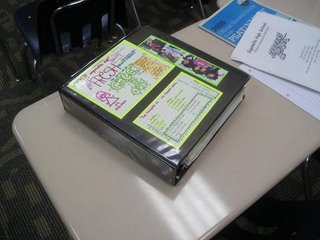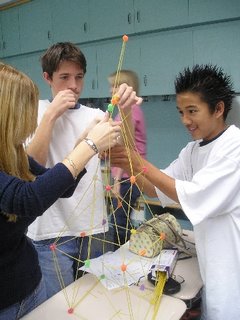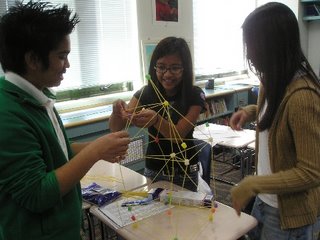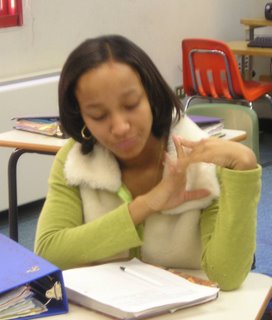Tuesday, October 31, 2006
Awesome End-of-Quarter Binders!

These high school AVID students again excelled on their binder checks on October 30. Congratulations!
A+ (100-105%)
11th grade: Carlo A and Patrick F
10th grade: Miguel and Tim F
9th grade: Caitlin G, Elishah H, Kiersten D, Aica D, Reggie G, Joelle N, Niko R, and Alex T
8th grade: Marco M
A (90-99%)
11th grade: Chris K, Kevin R, and Mia S
10th grade: Nico L and Brittany B
9th grade: Patrick B and Camron S
Collaborative Architecture

The high school AVID students enjoyed an activity called Collaborative Architecture yesterday while their binders were being graded and school photos taken. The goal for each group was to create the highest freestanding structure using only dry spaghetti and gumdrops in a fifteen-minute timeframe. Oh, and the group COULD NOT TALK during the activity!




Friday, October 27, 2006
College Savings Bank
The CollegeSure CD is a college cost prepayment product. It pays an annual percentage yield tied to the rise in college costs each year and it has a 2.00% floor rate for added protection. Over the one-year period ended July 31, 2006, the college inflation rate was 5.74%.
Each CD deposit of $250 or more is measured in terms of "units." Units are a measure of how much college you've prepaid. One unit, at maturity, is equal to one full year's average tuition, fees, room and board at a four-year private college as measured by the Independent College 500 Index (IC 500).
Latin American Educational Foundation
They have a terrific college prep section that includes:
- calendar and preparation
- college entrance exams
- degrees, programs, and schools
- financial aid
- scholarships
- internships and apprenticeships
- internet resources
End of Quarter Approaching Rapidly
Parents, please check with your children to ensure that this is happening.
The quarter grade reflects work done in the first quarter. Together with the second quarter and first semester exam, it will make up the first semester grade, which is the important one, the one that goes on student transcripts.
Thank you, Mrs. Frost!
Ms. Pienta, Ms. Sibayan, Ms. O'Connor, and Ms. Imlah
Report: College degree worth extra $23,000 a year
That is the average gap in earnings between adults with bachelor's degrees and those with high school diplomas, according to data from the Census Bureau.
College graduates made an average of $51,554 in 2004, the most recent figures available, compared with $28,645 for adults with a high school diploma. High school dropouts earned an average of $19,169 and those with advanced college degrees made an average of $78,093.
"There appear to be strong incentives to get a college degree, given the gaps that we observe," said Lisa Barrow, senior economist at the Federal Reserve Bank of Chicago.
The income gap narrowed slightly from five years earlier, when college graduates made nearly twice as much as high school graduates. But the differences remained significant for men and women of every racial and ethnic group.
Eighty-five percent of people 25 and older had at least a high school diploma or the equivalent in 2005, according to the Census Bureau's 2005 Current Population Survey. In 2000, 80 percent had a high school diploma or the equivalent, and a little more than half did in 1970.
Twenty-eight percent had at least a bachelor's degree, compared with about 24 percent in 2000 and 11 percent in 1970.
"I think we've done a very good job of getting individuals into college," said Cecilia Rouse, professor of economics and public affairs at Princeton University. "But we don't fully understand why we don't do as good a job of graduating them."
Chester Finn, president of the Thomas B. Fordham Institute in Washington, said too many high school graduates are unprepared to succeed in college.
"If you don't emerge from high school having done at least the equivalent of advanced algebra, you are not going to be ready for college math," Finn said. "You can make similar points about English."
Among the other findings in the report:
Minnesota, Utah, Montana, New Hampshire and Alaska had the highest proportions of adults with at least a high school diploma -- all at about 92 percent.
Texas had the lowest proportion of adults with at least a high school diploma, about 78 percent. It was followed closely by Kentucky and Mississippi.
Connecticut was the state with the highest proportion of adults with at least a bachelor's degree, nearly 37 percent. It was followed closely by Massachusetts, Maryland and New Jersey.
Nearly 47 percent of adults in Washington, D.C., had at least a bachelor's degree.
West Virginia had the lowest proportion of college graduates, at 15 percent. It was followed at the bottom by Arkansas, Kentucky and Louisiana.
Copyright 2006 The Associated Press. All rights reserved.This material may not be published, broadcast, rewritten, or redistributed.
Thursday, October 19, 2006
Subscribe for free to Student Financial Aid News!
On their main site you'll see links to back issues and their Student Financial Aid Newsletter e-zine as well as links to all the important financial aid sites, daily Podcasts, and scholarship updates.
This month, they have a featured article on Five Ways to Earn Spending Money.
Check it out! Subscribe!
High School Binder Check on October 30
Ms. Pienta
October Family Workshop Postponed
Tuesday, October 17, 2006
Farewell to Charnece

It is with great sadness that we say goodbye to tenth-grade AVID student Charnece H, who has been in the AVID program as Sigonella since August of 2004. Charnece has been a model student and classmate for all. She achieved A's in AVID every quarter along with Honor Roll status. Last year, she was inducted into the Junior National Honor Society. In high school, Charnece has been a varsity cheerleader and a member of the band. She and her parents supported every AVID event, including Family Workshops and the Planter Project.
Period 3 AVID participated in a farewell party for Charnece last week. She was presented with an AVID pin, letter of recommendation, and a certificate signed by all her classmates.
We know that she will continue to do well in high school and continue on to college for a bachelor's degree. Charnece and her family are relocating in Pensacola, Florida. We plan to stay in touch with her via email and AVIDEtna. Good luck and best wishes for future success, Charnece!
(See Charnece as an 8th grader in AVID below!)

Friday, October 13, 2006
On-line Assignment for High School AVID
Here is the scoring rubric for this and all on-line assignments:
SCORING:The following rubric will be used to score your online assignedpostings:
40 = Post was on time, in Standard Written English, had few or nowriting errors, was of appropriate length, and showed depth ofthought and/or originality
30 = Post was on time, in Standard Written English, had few writingerrors, may have been a little short in length, and showed lessthought and/or originality than the best examples
20 = Post was on time,in Standard Written English, had some writingerrors or was much shorter than most posting or lacking in depth ororiginality
10 = Post was late
0 = Post was missing or more than five school days late
Juniors Lead the Way on High School Binders
A+ (100-105%):
Juniors: Carlo A, Patrick F, Kevin R, Mia S,
Sophomores: Tim F, Miguel D, Charnece H, Nico L
Freshmen: Aica D, Reggie G, Caitlin G
8th Grade (Honorary Freshman): Marco M
A (90-99%):
Juniors: Asher B
Freshmen: Camron S, Joelle N
The next high school binder check will be on October 26.
PSAT This Wednesday!
Please make sure your child arrives equipped with two sharpened No.2 pencils. For your information, use of a scientific or graphing calculator is recommended, but not required. We also recommend that students eat breakfast and arrive well rested. All students will be dismissed in time to eat lunch and report to their regularly scheduled afternoon classes. It may be cold in the testing room, so students may want to bring additional layers of clothing.
Your child has received an Official Student Guide which, contains helpful information related to test sections, sample questions, and a practice test. Feel free to go over this information with your child prior to the test date. If you have additional questions, please feel free to contact Ms. Evelyn Chisari at 624-3284.
Thank you!
Friday, October 06, 2006
PSAT Prep Continues
For actual test question practice with answers and explanation, the College Board provides the most comprehensive practice. Click HERE for that practice section.
The PSAT, which is a practice test for the SAT, will be given at Sigonella High School on the morning of October 18. All AVID students in 8-11 will be taking this test.
The Princeton Review offers this advice for the SAT (and PSAT):
Order of Difficulty (OOD) Each SAT section is divided into three levels of difficulty: easy, medium, and hard. The first third of each group are easy, the second third are of medium difficulty, and the last third are hard. (The only exception is the Reading Comprehension passages, which do not follow this order.) An easy question is one that almost everyone gets right. A hard question is a question that almost everyone gets wrong.
So, if a group has nine questions, the first three are easy, the second three are medium, and the last three are hard. Since easy, medium, and hard questions are worth the same amount, spend the majority of your time making sure you get the easy and medium questions right.
Process of Elimination (POE) Instead of trying to find the right answer, try to find the wrong answers. By eliminating wrong answers, you greatly improve your chances of getting the question right because even if you can't narrow your choices to a single answer at the end, you will have only two or three to choose from instead of all five. Physically cross out the wrong answer choices in your test booklet, and then guess among whichever answer choices remain.
Only a quarter point is subtracted for every wrong answer, while a full point is added for every right answer. So, if you can eliminate at least one answer choice, guess among the two, three, or four remaining choices.
The Joe Bloggs Approach Joe Bloggs is a fictional, average American student. On the SAT he scores exactly what the average American student scores: 500 on each section. So why is Joe Bloggs important? He's important because he's predictable. Joe gets all the easy questions right, half the medium ones right, and none of the hard questions.
When you are taking the SAT, think about how Joe Bloggs would answer an easy, medium, or hard question. Joe Bloggs always picks the answer that seems right. If you can narrow down the answer choices to two or three choices on an easy question, you should pick the answer that seems right — the Joe Bloggs answer. On hard questions, find the answer that seems right and eliminate it — that's the Joe Bloggs answer. If you can eliminate even one answer, you should guess and move on. Easy questions have easy answers, and hard questions have hard answers.
Self-Discipline More Important than IQ?
By Jay Mathews
Washington Post Staff WriterTuesday, January 17, 2006; Page A10
"Zoe Bellars and Brad McGann, eighth-graders at Swanson Middle School in Arlington, do their homework faithfully and practice their musical instruments regularly. In a recent delayed gratification experiment, they declined to accept a dollar bill when told they could wait a week and get two dollars.
"Those traits might be expected of good students, certainly no big deal. But a study by University of Pennsylvania researchers suggests that self-discipline and self-denial could be a key to saving U.S. schools.
"According to a recent article by Angela L. Duckworth and Martin E.P. Seligman in the journal Psychological Science, self-discipline is a better predictor of academic success than even IQ.
"'Underachievement among American youth is often blamed on inadequate teachers, boring textbooks, and large class sizes,' the researchers said. 'We suggest another reason for students falling short of their intellectual potential: their failure to exercise self-discipline. . . . We believe that many of America's children have trouble making choices that require them to sacrifice short-term pleasure for long-term gain, and that programs that build self-discipline may be the royal road to building academic achievement.'
"But how, educators, parents and other social scientists want to know, do you measure self-discipline? Duckworth, a former teacher studying for a doctorate in psychology, and Seligman, a psychology professor famous for books such as Learned Optimism, used an assortment of yardsticks, including questions for the students (including how likely they are to have trouble breaking bad habits, on a 1-to-5 scale), ratings by their teachers and parents and the $1-now-or-$2-later test, which the researchers call the Delay Choice Task.
"The results: 'Highly self-disciplined adolescents outperformed their more impulsive peers on every academic-performance variable, including report card grades, standardized achievement test scores, admission to a competitive high school and attendance. Self-discipline measured in the fall predicted more variance in each of these outcomes than did IQ, and unlike IQ, self-discipline predicted gains in academic performance over the school year.'
"The study looked at one group of 140 eighth-graders and another group of 164 eighth-graders in a socioeconomically and ethnically diverse magnet school in a Northeast city. . . ."
"Some educators said schools can teach self-discipline. Rafe Esquith, an award-winning Los Angeles teacher, often tells his low-income fifth-graders about a study that showed that hungry 4-year-olds willing to wait for two marshmallows were more successful years later than those who gobbled up one marshmallow immediately.
"Ryan Hill, director of the TEAM Academy Charter School in Newark, N.J., said students at his school, a Knowledge Is Power Program middle school in a low-income neighborhood, are required to stay at school until their homework is done if TV interfered with study the night before. 'Over time, they learn to just do their homework before watching TV, delaying gratification, which becomes a habit of self-discipline,' Hill said.
"Educational psychologist Gerald W. Bracey noted the power of self-discipline in sports, citing tennis star Chris Evert, who triumphed over more talented players because she practiced more.
Martha McCarthy, an education professor at Indiana University, said such habits could be taught in early grades, with methods such as 'giving students time to visit with their friends if they have been attentive during a lesson. . . .'"
Tuesday, October 03, 2006
Middle School Binder Checks Plus MS Comments about Family Night
7th graders: 100-105 are Eboni, Kninique, Riley Mikayla, Justine, Madiea, Gabby, Sedric, Danelly, Tiera; 90-99 are Kierra, Sean, Nathan
8th graders: 105! Lakara, Jose, Jonathan
Way to go, Middle Schoolers!
Some comments from our Middle School about the first AVID family night:
"I like how everyone gets together and how we make a bond with our parents."
"I would like some high school projects on the walls, too."
"I really liked the speeches."
"I felt so happy to be in AVID."
"I thought that the AVID family night was really cool. I learned a lot since I am new in AVID. It was really nice to hear what high schoolers thought about AVID."
"Family night for me was a success. It helped me learn what AVID was all about and what things I could do to be a better AVID student."
" I had a good time, and I liked the cake."
"It was nice to see all the AVID students 6-11."
"I think family night was a good thing for parents and AVID students to get to know a lot more about AVID so we can sign a contract that shows we are going to do the recommendations for AVID."